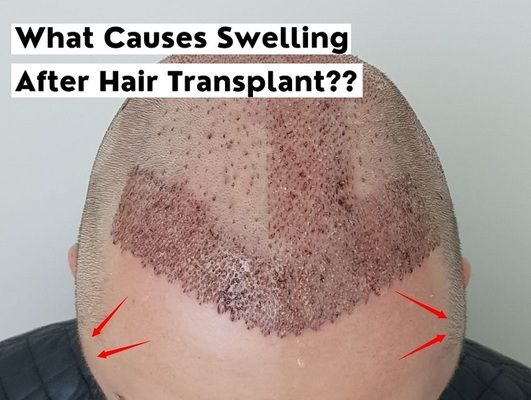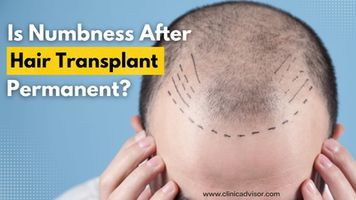
Medically reviewed & verified by Dermatologists at: Avrupa Hair Transplant Clinic
Written by: ClinicAdvisor
We’ve heard it a lot from patients who had a hair transplant saying: “I look like an alien, what’s happening to my face?!”
A few days after your hair transplant you will start noticing that your head is swelling gradually.
Swelling after hair transplant mainly targets the forehead, temples and the eyelids and that’s probably why patients liken themselves to “Aliens”.
In this article we will talk about the following:
- What is after hair transplant swelling?
- What causes it?
- How to get rid of it?
- How long does it last?
What is Swelling After Hair Transplant?
Although hair transplant is considered as minimally invasive and doesn’t include surgical intervention, that doesn’t mean it’s free of side effects.
Side effects after hair transplant such as swelling, scabbing and redness are very normal and temporary.
In the matter fact, swelling is one of the side effects that disappear very quickly after hair transplant given that you adhere to the instructions.
Most patients start noticing some minor swelling which appears first on the forehead 2 days after the surgery.  Forehead swelling after hair transplantThen by day 3-4 it gradually moves down to the temples and eyes as shown in the photo below:
Forehead swelling after hair transplantThen by day 3-4 it gradually moves down to the temples and eyes as shown in the photo below:
 Temples swelling after hair transplantIn some rare cases the eyes swell to the extent that patients cannot open their eyes. This is not seen in all patients but people experience different levels of edema.
Temples swelling after hair transplantIn some rare cases the eyes swell to the extent that patients cannot open their eyes. This is not seen in all patients but people experience different levels of edema.
And on other occasions this could be accompanied by ecchymosis of the eyelids (small bruise or discoloration). However, this is not widely seen in patients.
What Causes Swelling After Hair Transplant?
The main reason for swelling after hair transplant is fluid retention. Before the operation the anesthesiologist injects local anesthetic (lidocaine) into the recipient and donor sites.
Along with the anesthetic, isotonic fluid is injected into both the area to be transplanted and the donor area where hair will be taken from.
This makes the skin swell creating some space between the skull and the muscles which facilitates the extraction and implantation process.
A couple days after the operation these fluids start to come down on the forehead and eyes to be discharged eventually.
Swelling reaches its peak on the 4th day and completely disappears by the end of the first week post hair transplant.
That’s why it’s recommended to take at least one week off before going back to work after hair transplant. As it could be embarrassing for people to go to work with a swollen face.
How Long Will Swelling Last After Hair Transplant?
The amount of time that face swelling after hair transplant lasts vary depending on the individual and on their overall health.
Swelling after hair transplant starts to appear 2-3 days after the operation and reaches its peak on the 4-5th day.
It gradually decreases day by day and by the end of week one you should look very normal; although other side effects like redness and scabs after hair transplant will persist for a couple weeks.
Tips to Reduce Swelling After Hair Transplant
Now that you know what can cause swelling after a hair transplant, be sure to follow these tips to reduce it and get back to your life as quickly as possible!
- For the first 5 days keep your head elevated 45 degrees while sleeping after hair transplant.
- Apply ice compress on your forehead (make sure it doesn’t come in contact with the grafts), and on your cheeks right below your eyes for 15 minutes every 2 hours. This will help reduce swelling.
- Drink plenty of fluids to help reduce the swelling and keep your body hydrated by drinking at least 2 liters of water per day.
- Try not to walk a lot during the first 3 days to avoid excessive swelling. If you decide to go out for a walk, make sure to take a rest for 10 minutes every half an hour.
- Avoid any physical activity and strenuous exercising after hair transplant.
- Wear the head band given to you by the clinic when you go to bed and remove it in the morning. Do this for the first 5 days it will also help reduce swelling.
If after one week the swelling doesn’t go away, check with your doctor. He/she may recommend you to use some steroids.
Frequently Asked Questions
Is swelling normal after hair transplant?Swelling is one of the most common side effects after hair transplant. It is completely normal and there is nothing to worry about. In some instances it could be minor swelling on the forehead and eyes while in other cases it could be severe causing extreme eye puffiness. | How long till swelling goes down after hair transplant?It takes 5-7 days for swelling to completely subside after hair transplant. Day by day you will notice that the swelling is reducing. Also, you can follow some tips to reduce it such as using ice compresses, drink plenty of water and sleep with your head elevated 45 degrees. |
Is swelling permanent after hair transplant?Swelling that occurs after hair transplant is temporary. It goes away within one week. | Does eyelid swelling after hair transplant block the sight?In some extreme and rare cases swelling could be very severe to the extent that it's hard to open the eyes but this doesn't last too long. Only for 1-2 days maximum. Again this depends on each individual and how their body responds. |
How to get rid of swelling after hair transplant?Swelling is an inevitable part post hair transplant. But there are some ways to reduce it and make it subside faster. First of all patients must follow the instructions given to them by their doctor. In order to reduce swelling patients should sleep with their heads elevated using two pillows. Also, using an ice compress is very helpful in subsiding edema. In addition to that staying hydrated is very essential in the process of discharging the retained fluid from the body. | Why does face swell after hair transplant?The face, forehead and eyelids swell after hair transplant due to the fluids (isotonic) and anesthetic (lidocaine) injected into the scalp. The body starts discharging these fluids from the scalp by moving them down towards the forehead and the eyes area. |






Share Your Opinion, Please